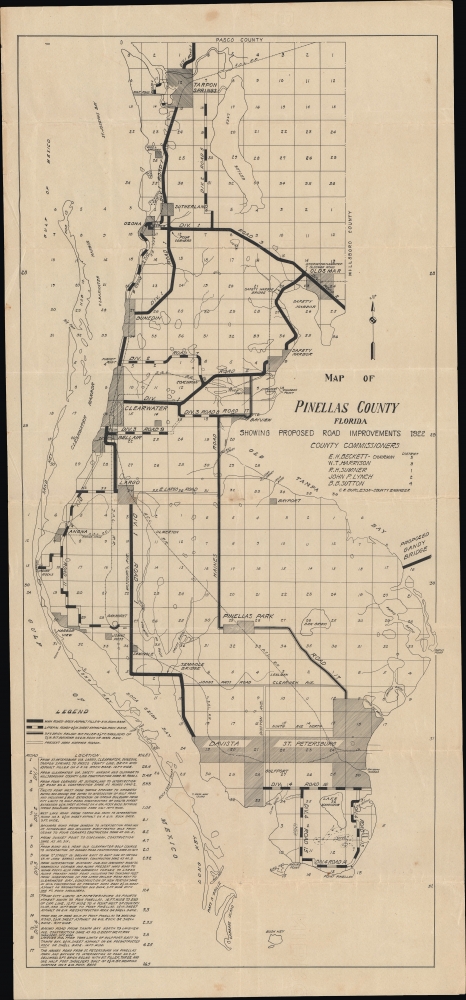This item has been sold, but you can get on the Waitlist to be notified if another example becomes available, or purchase a digital scan.
1922 Unrecorded Survey Map of Pinellas County, Florida
PinellasCounty-burleson-1922
Title
1922 (dated) 22.5 x 10 in (57.15 x 25.4 cm) 1 : 110000
Description
A Closer Look
Covering the entirety of Pinellas County, this map focuses on automobile roads, designated by quality of surface as noted in legend, below which the roads are numbered with their routes and lengths explained. The 'proposed' Gandy Bridge at right began construction in September 1922 and was opened in November 1924, constituting the first bridge across Tampa Bay. Aside from roads, railways are also indicated, namely the Seaboard Air Line and Atlantic Coast Line. Survey lines overlay the map, forming a numbered grid. Towns and cities are shaded with diagonal lines; although large portions of the peninsula are undeveloped, today the peninsula is a continuous urban and suburban development.Birthplace of Commercial Aviation
The small town noted here as Bayport is the location of today's St. Pete-Clearwater International Airport. It is notable as the site of the world's first ticketed commercial aviation flight on January 1, 1914, when an airboat service (the St. Petersburg - Tampa Airboat Line) piloted by aviation pioneer Tony Jannus flew 23 miles to Tampa. The open-air wooden airplane could reach a maximum speed of 75 miles per hour and glided above the bay at an altitude of 50 feet. It greatly reduced travel time between St. Petersburg and Tampa from over four hours by train to less than 25 minutes. Although it only operated for four months, the St. Petersburg - Tampa Airboat Line was a hallmark moment in the early history of aviation.Florida Land Boom
In the late 19th and early 20th century, Florida experienced a series of land booms and crashes; the most well-known of which occurred in the 1920s. The collapse of a previous land boom, that established Florida as a center for the citrus industry in the 1880s - 1890s, allowed for the low cost acquisition of large tracts of land at cut-rate prices. Industrialist and founder of Standard Oil Henry Flagler (1830 - 1913) seized the opportunity to build his Florida East Coast Railway and extend it to Miami on the state's southeastern coast.Flagler and other boosters of the region successfully promoted it as a paradisical escape from the grimy cities and cold weather of New England and the Mid-Atlantic. Land prices shot up at an astronomical rate, and developers carved entirely new cities out of wetlands in mere months. In addition to Flagler's railway, the arrival of the highway system and associated businesses (gas stations, motels, restaurants, etc.) in the 1920s made the region more easily accessible. However, the speculation around land prices in Florida had reached irrational heights, and the damage caused by two hurricanes, followed by the financial crash of 1929, led to a collapse in the real estate market, ruining many investors in the process.
Publication History and Census
This map was prepared by county engineer C. E. Burleson. It is undated, but shows road improvements to 1922, strongly suggesting a date of 1922 or 1923. We are unaware of any other examples of this map in institutional collections or on the market.Cartographer
Carl E. Burleson (c. 1889 - 1961) was a civil engineer who served as the county engineer of Pinellas County, Florida during the 1920s Florida Land Boom. He is credited with designing many of the bridges constructed in the county during that decade. Burleson was born in North Carolina in 1889, raised in Tennessee, and first came to Florida in the early 20th century, settling in Pensacola. In the late 1910s, he moved to St. Petersburg and served as the county engineer for 22 years. Then, in the early-mid 1930s, he relocated to Jacksonville, before moving again to Volusia County in the mid-1940s, working for the State Road Department throughout as a maintenance engineer. His son Gordon followed in his footsteps and served as the director of engineering for the City of Orlando. Carl Burleson was one of the first registered engineers in Florida and a leader in the Florida Engineering Society and the American Society of Civil Engineers. More by this mapmaker...

